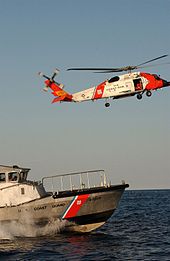Sikorsky HH-60 Jayhawk
The Sikorsky HH-60J Jayhawk is a multi-mission, twin-engine, medium-range helicopter operated by the United States Coast Guard for search and rescue, law enforcement, military readiness and marine environmental protection missions. The HH-60J is designed to fly a crew of four up to 300 mi (483 km) offshore, hoist up to 6 additional people on board while remaining on-scene for up to 45 minutes and return to base while maintaining an adequate fuel reserve. Normal cruising speed of the HH-60J is 135 to 140 kn (155 to 161 mph) and the aircraft is capable of reaching 180 kn (207 mph) for short durations. The HH60J can fly at 140 kn (161 mph) for six to seven hours.
Chosen to replace the HH-3F Pelican, the HH-60J is a member of the Sikorsky S-70 family of helicopters and is based on the United States Navy's SH-60 Seahawk helicopter. Development began in September 1986, first flight was achieved on August 8, 1989, and the first HH-60J entered USCG service in June 1990. Production ended in 1996 after 42 helicopters were produced.
The MH-60T Medium Range Recovery Helicopter upgrade program began in 2007 and is scheduled to provide upgraded avionics and operational capabilities to all 42 existing HH-60J airframes by 2015. As each airframe upgrade is completed, the affected HH-60J will be re-designated to MH-60T.
Design
With a fuel capacity of 6,460 lb (2,930 kg), the HH-60J is designed to fly a crew of four up to 300 mi (483 km) offshore, hoist up to 6 additional people on board while remaining on-scene for up to 45 minutes and return to base while maintaining an adequate fuel reserve. Normal cruising speed of the HH-60J is 135 kn (155 mph) to 140 kn (161 mph) and the aircraft is capable of reaching 180 kn (207 mph) for short durations. The HH60J can fly at 140 kn (161 mph) for six to seven hours.
The HH-60J uses the NAVSTAR Global Positioning System as its primary long range navigational aid, using a Collins RCVR-3A radio to simultaneously receive information from four of the NAVSTAR system's 18 worldwide satellites.
The HH-60J is normally based on land but can be based on 270 foot medium endurance Coast Guard Cutters (WMEC) or 378 foot high endurance Coast Guard Cutters (WHEC).
The HH-60J has a radar for search/weather that gives its nose a distinctive look. A forward looking infrared (FLIR) sensor turret can be mounted below its nose. It can carry three 120 US gal (454 L) fuel tanks with two on the port side rack and one on the starboard side rack. The starboard side also carries a 600 lbf (2.67 kN) capacity rescue hoist mounted above the door. The hoist has 200 ft (61.0 m) of cable.
Specifications (HH-60J)



- Most data is for HH-60J. Data for MH-60T is noted below.
Data from USCG HH-60J information, Sikorsky S-70B Seahawk information, Globalsecurity.org HH-60J specifications
General characteristics
- Crew: Four (pilot, co-pilot, two flight crew)
- Length: 64 ft 10 in (19.76 m)
- Rotor diameter: 53 ft 8 in (16.36 m)
- Height: 17 ft (5.18 m)
- Empty weight: 14,500 lb (6,580 kg)
- Max. takeoff weight: 21,884 lb (9,926 kg)
- Powerplant: 2 × General Electric T700-GE-401C gas turbines, 1,890 shp (1,410 kW) each
Performance
- Maximum speed: 180 knots (205 mph, 333 km/h)
- Cruise speed: 140 knots (160 mph, 260 km/h)
- Range: 700 nautical miles (802 mi, 1,300 km)
- Service ceiling: 5,000 ft hovering (1,520 m)
Armament
- 1 x 7.62 mm (0.30 in) M240H medium machine gun in starboard door (MH-60T)
- 1 x 0.50 in (12.7 mm) Barrett semi-automatic rifle (MH-60T)
The information contained on this page is unclassified, approved for public dissemination and is released under CC-BY-SA Licensing Agreement.

